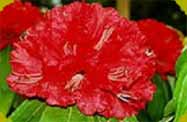|
Acorus calamus
Linn.

|
Species |
Acorus calamus
Linn. |
|
Local Name |
Bojo (Nep),Riklok(Lep) |
|
Synonym |
Aconitum ferrox
Wall. Ser. |
|
Family |
Ariaceae |
|
Habitat |
The plant is a semi-aquatic herb,
found in moist places near riversides and rice fields
throughout India up to 1800 m. |
|
Distribution |
It is commonly distributed in tropical and temperate
region. |
|
Sikkim |
Padamchen, Dentam, Pangthang, Kabi, Dzongu, Rabong,
Tingbong, Makha and grown in the kitchen all over
Sikkim in temperate - sub temperate region. |
|
Out side |
Jammu and Kashmir. |
|
General |
Europe, North Asia, Himalaya (Nepal, Bhutan), SirLanka,
South Tibet, China, Japan, and Central & Northern
America. |
|
Morphological |
Marsh or emergent aquatic herb,
rhizomes aromatic, horizontal bearing leaves at apex.
Leaves asymmetric, apex acute, 30-445x11.2 2 cm, midrib
conspicuous, glabrous. Spadix straight or slightly
curved, 4-5x0.5-0.8 cm, greenish. Sepals oblong, apex
triangular, hooded, membranous. Ovary hexagonal. Berries
few seeded. |
|
Flowering |
April-July |
|
Fruiting |
August-October |
|
History |
Rhizome |
|
Parts |
Endangered in wild |
|
Status |
|
|
Phytochemistry |
|
|
Agrocultivation |
|
|
Reference |
1. Kirtikar, K.R; B.D Basu (1994).
Indian Medicinal Plants (Vol. III) Bishen Singh Mahendra
Pal Singh. 1899 -1902.
2. Progress Report of the Project
"Studies on Medicinal Plants of Sikkim" (1998-2001).
State Council of Science and Technology for Sikkim.
3. Rai, Lalit Kumar and E. Sharma
(1994). Medicinal Plants of Sikkim Himalaya. Bishen
Singh Mahendra Pal Singh, Dehradun. 28- 29.
4. Sairam, T.V. (1999). Home Remedies
(Vol. 2). Penguin Books. 17 -18.
5. Singh, Janardhan, Ashok Sharma,
Subash Chandra Singh, Sushil Kumar (1999). Medicinal
Plants for Bioprospection (Vol. 1). Central Institute of
Medicinal and Aromatic Plants. Lucknow. 43-44.
6. Thakur, R.S., H.S. Puri, Akhtar Hussain (1989). Major
Medicinal Plants of India. Central Institute of
Medicinal and Aromatic Plants Lucknow. 28-30. |
|
Medicinal |
|
|
Ayurvedic |
|
|
Unani |
The rhizome has a very bitter sharp taste; laxative,
expectorant, crminative, alexiteric, tonic to the brain,
emmenagogue; useful in general weakness, stomatitis,
toothache, inflammations, pain to the liver and the
chest, kidney troubles, leucoderma. |
|
Traditional |
The plant is an age-old remedy for fever in the hills. |
|
Others |
Small piece of rhizome is given
orally in case of gastritis and stomach pain; and is
chewed in case of tonsillitis and cough.
The rhizome is used for cough, cold,
vomiting, stomach pain, flatulence, and eczema and skin
diseases. It is preventive against malaria and when
taken with quinine stops remittent fever. Oral
administration of 15 -20 gm daily stops asthma.
Decoction from rhizome is used to cure gout and
rheumatism; stem used in skin diseases, boils, sores,
gout, rheumatism and diabetes; paste from shoots is
applied externally on scabies, small pieces of dried
shoots are chewed as brain tonic. |
|
Prepartation |
|
|
Picture |
|
|
|
|
|

Rhododendron


Amongst the many
floral treaties of Sikkim Himalaya one of the earliest ones may be
found over the genus Rhododendron (Gk. rhodo = red, dendrons = tree
). |
| |
|
|
|

Orchid


Orchid
known for their brilliance in colors, unusual shapes
attractive growth habits, variety in fragrance and
exquisite beauty can attract any nature lovers.
|
| |
|
|
|

Medicinal Plant


Sikkim
with its total geographical area of 7,096 sq km is
bestowed with a huge diversity of flora and fauna.
|
| |
|
|
|
|
|